March 23, 2022 Minutes
Faculty Senate Meeting Minutes (Leon Johnson 346)
03.23.2022
3:15pm – 4:30pm
|
Name |
Represents |
Attended |
|
Watson, Bradford |
Chair |
x |
|
Brody, Michael |
Chair-Elect |
x |
|
Anderson, Ryan |
EN/Chemical Engineering |
x |
|
Carson, Robert |
EHHD/Education |
x |
|
Caton, Gary-Webex |
Business |
x |
|
Cowan, Susanne |
AR/Architecture |
x |
|
Dale, Catherine-Webex |
AR/Film & Photo |
x |
|
Ellis, Colter |
LS/Sociology & Anthropology |
x |
|
Flory, Dan |
LS/History & Philosophy |
x |
|
Gao, Hongwei-Webex |
EN/Electrical & Computer Engineering |
x |
|
Gedeon, Tomas |
LS/Mathematics |
x |
|
Hansen, Andy-Webex |
LS/Ecology |
x |
|
Herman, Matthew-Webex |
LS/Native American Studies |
x |
|
Hill, Andrew |
AG/Agricultural Economics |
x |
|
Lachapelle, Paul-Webex |
LS/Political Science |
x |
|
McPhee, Kevin-Webex |
AG/Plant Sciences & Plant Pathology |
x |
|
McWethy, David |
LS/Earth Sciences |
x |
|
Miller, Zach-Webex |
AG/Research Centers |
x |
|
Moyce, Sally |
Nursing/On Campus |
x |
|
Orendorff, Karie-Webex |
EHHD/Health & Human Development |
x |
|
Rebane, Aleks |
LS/Physics |
x |
|
Rognlie, Juli |
Gallatin College |
x |
|
Stoneback, Sarah-Webex |
AR/Music |
x |
|
Thomas, Amy-Webex |
LS/English |
x |
|
Tillack, Peter |
LS/Modern Languages |
x |
|
Van Emon, Megan-Webex |
AG/Animal & Range |
x |
|
Walter, Mat-Webex |
Extension/Off Campus |
x |
|
Young, Scott-Webex |
Library |
x |
|
Alternates |
Represents |
Attended |
|
Johnson, Erick |
EN/Mechanical & Industrial Engineering |
x |
|
Stowers, Steve-Webex |
AG/Microbiology & Cell Biology |
x |
|
Thomson, Jennifer |
AG/Animal and Range Sciences |
x |
|
OTHER ATTENDEES |
Represents |
Attended |
|
Adams, Dean |
Center for Faculty Excellence |
x |
|
Austin, Eric |
Political Science |
x |
|
Blackler, Kristin |
Sustainability |
x |
|
Donohue, Ariel-Webex |
Diversity & Inclusion |
x |
|
Edlund, Paul |
Sustainability |
x |
|
Elliot, Duke |
Sustainability |
x |
|
Hook, EJ-Webex |
Facilities Services |
x |
|
Provost Mokwa |
Provost |
x |
|
Sobek, Durward |
Provost Office |
x |
|
Swinford, Steve |
Provost Office |
x |
|
Tolleson, Paige |
Sustainability |
x |
|
Verho, Rose |
Sustainability |
x |
|
Yeoman, Carl-Webex |
AG/Animal and Range Sciences |
x |
|
Liz Webber-Webex |
Bozeman Daily Chronicle |
x |
I. Call to Order
a. Meeting was called to order at 3:19pm due to updating computer.
II. Approval of FS Minutes from March 09, 2022
a. Tomas Gedeon moves to approve. Andrew Hill seconds. None opposed. No abstentions. Minutes are approved.
III. FYI items
a. MyInfo Rolling Upgrades
i. https://www.montana.edu/uit/pmo/currentprojects/myinfoupgrade/
b. Outreach & Engagement See Grant Program, due April 11, 2022
i. Up to $5,000 available
ii. https://www.montana.edu/calendar/events/40821
c. Sustainability Summit
i. https://montana.edu/sustainability/summit/summit.html
ii. Keynote Lecture Monday April 18 at 5pm
iii. Student Poster Session April 19, 9-12
A. https://www.montana.edu/sustainability/summit/poster-submission.html
iv. Reports from Campus April 19, 1-5
d. Senator Hour, Monday 11:30-12:30 and Thursday 10:30-11:30 via WebEx
IV. Information Updates:
a. Sustainability Summit
i. https://montana.edu/sustainability/summit/summit.html
ii. Call for Student Posters
A. https://www.montana.edu/sustainability/summit/poster-submission.html
b. Scope 2 Emissions – Office of Sustainability, Kristin Blackler, Eric Austin
i. Greenhouse Gas Scope 2 emissions are indirect GHG emissions associated with the purchase of electricity, steam, heat, or cooling
A. Electrical System Structure
B. Electricity Suppliers & Contracts
C. Electricity Supply Portfolio
D. Reducing Scope 2 –
1. Onsite Electricity Generation (Existing & Future)
2. MSU Energy Strategy
E. 
ii. MSU is committed to achieving carbon neutrality
Actively addressing both energy supply and demand by:
A. Reduce Energy Use - system efficiency and integrated design practices
B. Reclaim Energy - previously treated as waste through Energy District philosophy
C. Integrate Renewable Energy and Systems - enable low carbon operation
D. 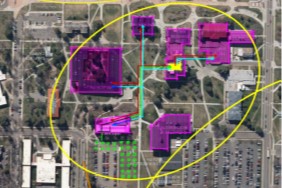
iii. Main Campus Meter – accounts for majority of campus electricity
iv. NorthWestern Energy
A. MSU considered Quasi-Choice customer (since 2007)
1. Northwestern Energy retail customer (bundled supply and distribution) AND
2. Supply by third party (WAPA) with distribution by NorthWestern Energy
B. Only entity in Montana with Quasi-Choice designation
C. MSU cannot change mix (per Montana Code Annotated)
v. Western Area Power Administration (WAPA)
A. Hydropower
B. Distribution by NorthWestern Energy
C. Original supply contract 2007; current contract 1/1/2021 – 12/31/2050
vi. Electricity Supply – Total Campus
A. 
B. 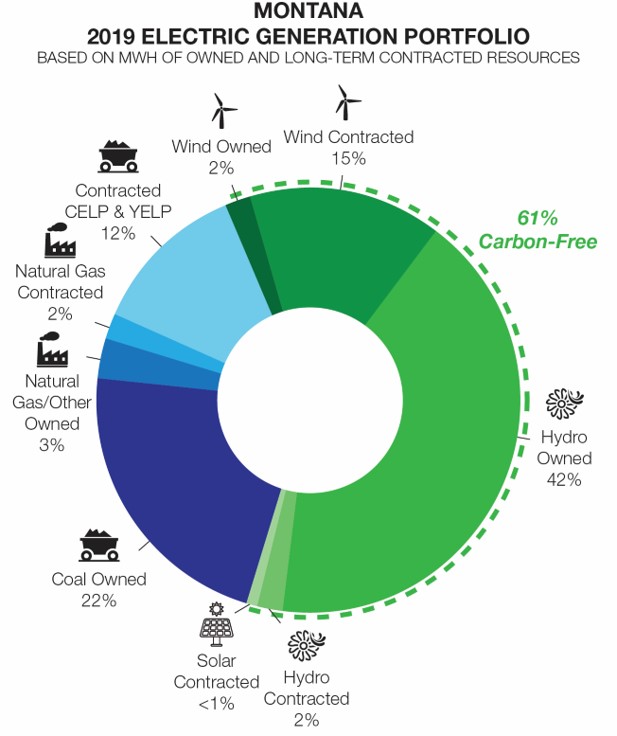
C. 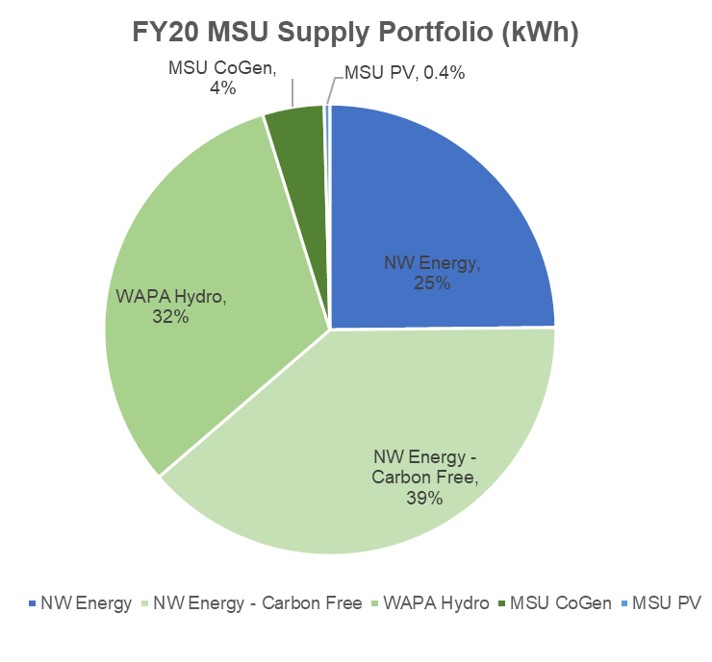
vii. MSU Electricity Source Profile (FY 21)
A. 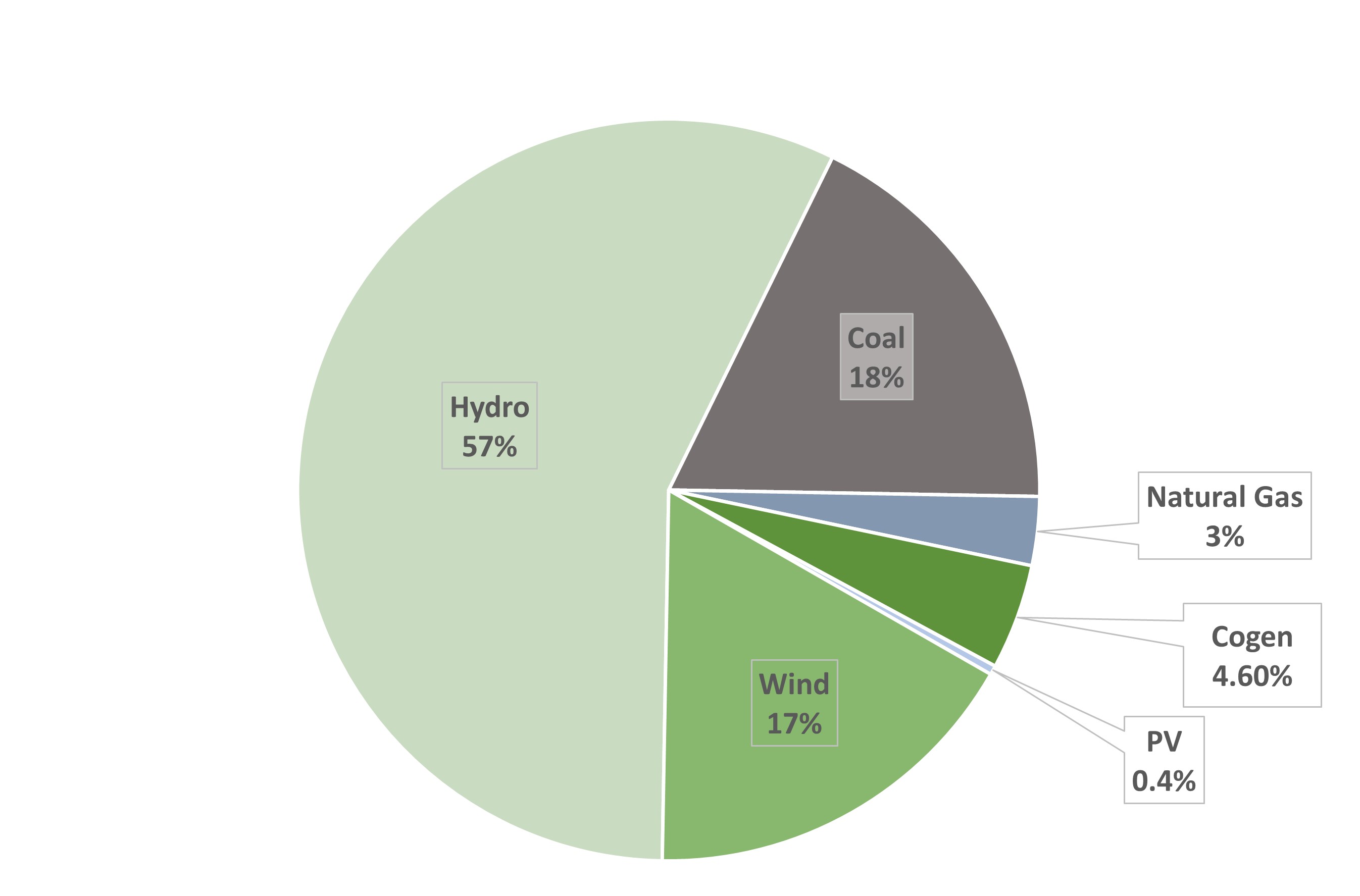
viii. Scope 2 Emissions Opportunities and Challenges:
A. Opportunities
1. Conservation efforts at MSU
2. Greening the Grid / Renewable Rate
B. Challenges
1. NWE announced a carbon neutrality date of 2050
2. Electrification of building and vehicle sector increases demand for Scope 2
ix. Overview Electric On-site Generation
A. Scope 1 – direct GHG emissions from sources that are controlled or owned by an organization (e.g., emissions associated with fuel combustion in boilers, furnaces, vehicles)
1. MSU Heating Plant Cogeneration
2. MSU Photovoltaics
B. Relates to Scope 2 – onsite generation (Scope 1) reduces the amount of purchased electricity (Scope 2) from NW Energy & WAPA
C. When onsite generation is from renewable sources, reduces campus GHG emissions
x. Future Electric On-site Generation
A. Photovoltaic Future Plans
1. Wellness Center (up to 400 kW)
2. Solar-ready options (no funding in place) – Hyalite Hall, Yellowstone Hall, Jabs Hall, Parking Garage
B. Future Options & Hurdles
1. All future installations – first must install non-export controls at main campus meter (NW Energy Southside Substation); project cost likely $100k +
2. Existing building installations – expensive due to required upgrades of existing electrical infrastructure (i.e., parking garage example)
3. Large-scale installations – typically use Public-Private-Partnership (P3) agreement; method not approved by Montana Legislature
4. Large-scale installations – must consider emergency power sources (NW Energy) and contracts / costs to hold capacity
5. Would need very large installation to meet all of campus need; NAH example (216kW installed) can meet entire building load at times (weekends), but is only 20% building annual kWh
xi. Electrical System Structure
A. Main Campus
1. Connected to NW Energy southside substation
2. Distribution on campus via MSU electrical grid
3. Meters: single NW Energy meter at College & 11th; MSU internal submeters at buildings
4. Generation: NW Energy and WAPA
5. Rates:
i. NW Energy bundled substation supply & distribution rates
ii. WAPA generation rate & NW Energy third-party distribution rate
B. Some Other Buildings
1. Direct feeds from NW Energy
2. Meters: Each with individual meter
3. Generation: NW Energy
4. Rates: NW Energy E110GS (typical)
5. Example: Museum of Rockies
6. 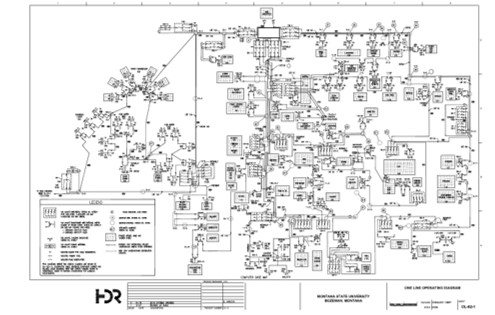
xii. Questions
B. Net metering: they need to lower the threshold before we would be able to do that.
1. Not allowed to push anything extra out onto the grid.
2. NWE limits for what they would allow and have lifted that slowly.
C. How can faculty help? What should they be thinking about to engage with this?
1. As campus grows, the size of our “pie” is going to grow.
i. Working to figure out how to shrink our pie.
2. Scope 3: Being focused on all of those things in Scope 3. Hard to measure. Takes the effort of many people to get it done.
i. Example: Single occupancy vehicles to campus.
3. Will need to be thinking about some of the bigger policy issues.
i. Example: Restrictions on rending out rooftop space
ii. NWE is also constrained by the rules
a. Cannot operate the way companies in other states do/can because of policy
iii. Many little things we can do, but if we really want to shrink the blue pie piece, we need to change policy.
D. Paul Lachapelle:
1. Would be great if scope 1 and 2 meetings were open to faculty and even students.
2. Data on cost of solar has far exceeded our wishes for how quickly it dropped.
3. MSU owns over 1,500 acres across the valley.
i. Vaulting/storing energy
ii. Are we looking at this?
1. Yes. Everything is on the table.
2. The land is MSU’s but also the College of Agriculture’s
3. What is possible? What is a waste of your time and energy?
E. Tomas Gedeon:
1. Buildings on campus are probably not very efficient. Cost would be an issue, I assume.
2. How do we engage campus to lower their energy consumption?
i. Behavioral changes
ii. Paul Edlund
a. Sustainability audit for your classroom or office.
b. Would love to see all of campus involved in this.
F. Colter Ellis:
1. Thanks for doing all of the work you do.
G. Don’t forget the student poster session that is a part of the Sustainability Summit!
c. Board of Regents meeting follow up
i. MUSFAR always start their formal meetings with a breakfast with the BOR and OCHE and leadership of other campuses.
A. Task Force-What did we learn from the pandemic? What can we bring with us? What do we want to leave behind?
1. Divided up into small groups for discussion.
2. BOR acknowledged how big of lift it was to change gears during the pandemic.
3. System wide resources we may need:
i. How do we share our resources?
ii. MSU-Billings has done great work on remote learning.
iii. Conference next month in Butte looking at that extended learning. Sharing ideas and successes.
4. Mental health
i. Students
a. What are we doing?
b. Students from Missoula came and talked about their worry around the students’ mental health.
5. Cost of living issues in Bozeman
i. Effects our ability to recruit and retain staff and faculty
a. And therefore, students
B. Ended meeting with a consideration of trying not to replicate what we went through last year with the legislative session.
1. Extra Faculty Senate meetings, etc.
2. How can we head that off at the pass?
i. Left with a feeling of real cooperation. We want to help them, and they want to help us.
C. Meet again in May
ii. Thank you for the relationships you have made over the last few years.
V. Undergraduate Courses and Programs
a. Courses – First Reading
i. AHMS 210 : Basic Medical Coding (Fall 2022)
ii. CSTN 100 : Fundamentals of Construction Technology (Fall 2022)
iii. CSTN 105 : Introduction to Woodworking (Fall 2022)
iv. CSTN 120 : Carpentry Basics and Rough-In Framing (Fall 2022)
v. CSTN 122 : Beginning Carpentry Lab (Fall 2022)
A. Workforce programs
b. Courses Changes– First Reading
i. NRSG 469 : Culturally Responsive Care in Nursing: The (Specific Culture) Experience
A. Title changed from: NRSG 469 : Cultural Applications Apps in Nursing: The (Specific Culture) Experience
c. Courses – Second Reading
i. HONR 408 : Wolves in Yellowstone: A Social, Scientific and Visual Journey, (Fall 2022)
d. Courses Changes– Second Reading
i. M 063 : Foundations of Mathematics
A. Credit change from 2 to 1
ii. ECNS 432R : Economic Policy Evaluation
A. Title change from Benefit-Cost Analysis
iii. PHSX 331 : Methods of Computational Physics
A. Credit change from 1 to 2
1. Universal agreement by faculty and students that two credits of work is required to meet learning outcomes.
e. Courses Inactivations – Second Reading
i. ARAB 201D : Intermediate Modern Arabic I
A. No longer offered
ii. ARAB 202D : Intermediate Modern Arabic II
A. No longer offered
iii. ARTZ 282 : Photographic Image and its Construction
A. The faculty member who taught the course is no longer at MSU.
f. Programs
i. None at this time
g. Program Inactivation
i. None at this time
VI. Graduate Courses and Programs
i. None at this time
VII. Old Business
a. Sabbatical Evaluation Scoring
i. Current Scoring System for Sabbatical Applications
A. Scholarly Merit (15 points)
1. How does the proposed activity contribute to the faculty member’s teaching and/or scholarship activity? (5 points)
2. To what extent does the proposed activity explore creative and original concepts? (5 points)
3. How qualified is the applicant to conduct the project? (5 points)
ii. Proposed Scoring System and Justification for Changes
A. Scholarly Merit and Integration (20 points)
1. How does the proposed activity contribute to the faculty member’s teaching and/or scholarship activity? (10 points)
2. To what extent does the proposed activity explore creative and original concepts? (5 points)
3. How well does the project contribute to the faculty member’s integration of teaching and scholarship activity? (5 points)
iii. Current Scoring System for Sabbatical Applications
A. Planning and Organization (10 points)
1. How organized is the proposed activity? (4 points)
2. Has there been adequate practical planning and intellectual preparation to carry out the project? (3 points)
3. Are there adequate resources to accomplish the project in the allotted time? (3 points)
iv. Proposed Scoring System and Justification for Changes
A. Planning and Organization (5 points)
1. Has there been adequate practical planning and intellectual preparation to carry out the project?
v. Current Scoring System for Sabbatical Applications
A. Broader Impacts (10 points)
1. What impact will this project have for MSU, the State of Montana, and the Rocky Mountain region? (Will it be disseminated through local/regional publication[s], performance[s], presentation[s], etc.?) (3 points)
2. How important is the proposed activity to advancing knowledge and understanding within the candidates own field and across different fields? (4 points)
3. What impact will the project have nationally or internationally? (Will it be disseminated through national/international publication[s], performance[s], presentation[s], etc.?) (3 points)
vi. Proposed Scoring System and Justification for Changes
A. Broader Impacts (10 points)
1. How does the proposed project integrate/align with the current institutional strategic plan? What are the regional, national, and international impacts of the proposed work?
vii. Current Scoring System for Sabbatical Applications
A. In addition to the criteria listed above, applicants also receive credit based on the following:
1. Years of service: ¼ point per year since eligible for sabbatical – i.e., after banking 7 years
2. Meritorious performance: Candidates can receive up to 3 additional points for meritorious performance in 1) Teaching, 2) Scholarship and 3) Service (Up to one point is awarded in each category).
3. Meritorious performance can include honors within an applicant’s discipline, University awards, etc. A record of publication, long-term teaching, or continuous service at MSU are deserving of note but do not, in and of themselves, guarantee that an applicant will receive a full point in any category of merit.
4. Academic rank: Add 2 points for Professor and 1 point for Associate rank.
viii. Proposed Scoring System and Justification for Changes
A. In addition to the criteria listed above, applicants also receive credit based on the following:
1. Years of service: 7-12 years from eligibility or last sabbatical – 0 points , > 12 years from eligibility or last sabbatical – 1 point
2. Academic rank: Add 2 points for Professor and 1 point for Associate rank.
ix. Additional proposed changes
A. Request a minimum of two outside and two internal letters
1. Ask letter writers to speak to the qualifications of the applicant to perform the proposed work.
2. The scholarly merit of the proposal
3. The broader impacts of the proposal
B. Provide guidance to deans and department heads to avoid ranking proposals and to speak to the administrative requirements rather than the individual merits of the proposal.
x. Thank you to Jennifer for her committee’s work on this.
xi. Please bring comments and questions to our next meeting before we talk about endorsing the changes.
b. Chair Elect nominations for Faculty Senate
i. One year as Chair Elect, one as Chair and one more as Past Chair
ii. Has been expanded to all tenured faculty members. Do not have to be a senate member.
iii. Happy to meet with anyone who has questions.
iv. It is to the body of the senate who you want to represent you.
c. Senators
i. Terms will be ending for some. If you are interested in being re-elected, let your department know.
VIII. New Business / Senators’ Open Conversation
a. None
IX. Public Comment
a. Provost Mokwa: Bradford and Michael gave a good recap of the meeting with the BOR. The strategy that the leadership used with the Regents was very successful. It was very effective.
i. Grabbed them initially on what is the most important to them-our students.
A. How do faculty need to make our students more successful?
ii. Regent came to leadership and asked more about what they were thinking about. First time ever approached by a Regent.
X. Adjourn
a. Tomas Gedeon moves to adjourn. Andrew Hill seconds. Meeting is adjourned at 4:12pm.
